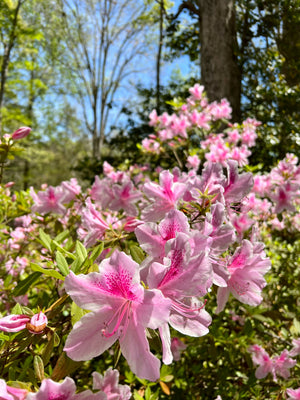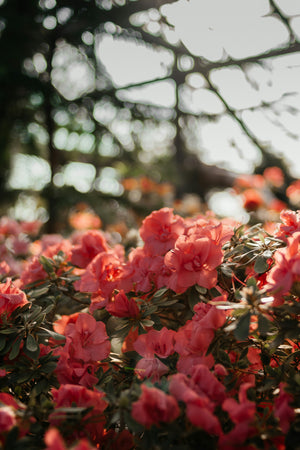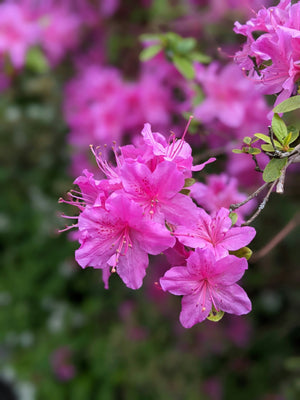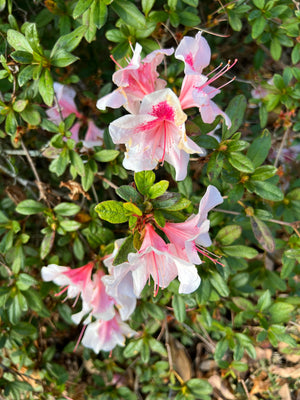The Azalea Guide
Azaleas, members of the Rhododendron genus, are known for their prolific blooms, wide color range, and adaptability to various landscape settings. Whether evergreen or deciduous, azaleas bring a burst of spring and summer color to woodland gardens, foundation plantings, or container arrangements. Their compact form, tolerance for shade, and compatibility with acid-loving plants make them a versatile choice for gardeners across the country.

About
Azaleas are part of the Ericaceae family and fall within the broader Rhododendron genus. While all azaleas are rhododendrons, not all rhododendrons are azaleas. Generally, azaleas have smaller, thinner leaves and bloom earlier than their larger-leaved rhododendron relatives. They are available in both deciduous and evergreen varieties and are native to Asia and North America.
Cultivars range from low-growing groundcovers like Rhododendron 'Gumpo Pink' to upright deciduous types like Rhododendron 'Gibraltar' and Rhododendron 'Golden Lights', known for their fiery orange and golden blooms. For season-long interest, evergreen types like Rhododendron 'Girard's Crimson' or Rhododendron 'Hino Crimson' offer dense foliage and vivid color. Newer introductions such as Rhododendron 'Roblec' (Encore Azalea series) bloom multiple times a year, extending the flowering season into fall.
Azaleas are a top choice for pollinator gardens, shaded borders, and woodland edges. When planted in mass, they create stunning focal points that light up the spring garden.

PLANTING
- USDA Hardiness Zones: Most azaleas thrive in Zones 5–9, though some evergreen types prefer warmer climates.
- Soil: Azaleas prefer moist, well-drained, acidic soil with a pH between 4.5 and 6.0. Amending soil with peat moss or pine fines can help create ideal conditions.
- Sunlight: Partial shade is ideal, especially in hot climates. In cooler zones, morning sun and afternoon shade provide the best balance.
- Watering: Water deeply and consistently during the first year to establish roots. Mature plants are somewhat drought tolerant but benefit from regular watering in dry periods.
- Spacing: Space plants 3–6 feet apart depending on the mature size of the variety.
- Planting Time: Early spring or fall are the best planting times to give roots a chance to settle before extreme weather arrives.
To plant, dig a hole twice as wide but only as deep as the root ball. Position the plant so the top of the root ball sits slightly above the soil line. Water thoroughly and mulch with pine bark or shredded leaves to retain moisture and suppress weeds.

CARE
Azaleas require minimal care once established, but a few routine tasks can help keep them vibrant:
- Watering: Maintain evenly moist soil, particularly during bud development and blooming. Avoid overhead watering to prevent fungal disease.
- Fertilizing: Use a fertilizer formulated for acid-loving plants. Apply in spring after blooming and again in midsummer if needed.
- Pruning: Prune right after flowering to shape plants and remove dead or crossing branches. Avoid pruning in late summer or fall, as it can remove next year’s flower buds.
- Mulching: Maintain a 2-3 inch mulch layer year-round, avoiding contact with stems to prevent rot.
- Pest Management: Watch for lace bugs, spider mites, and azalea caterpillars. Neem oil or insecticidal soap can help manage infestations.

HOW TO USE
Azaleas can be used in a wide variety of garden settings, from formal borders to naturalized woodland plantings. Their ability to light up shaded areas makes them an excellent design element:
- Foundation Plantings: Varieties like Rhododendron 'Girard's Pleasant White' and 'Tradition' offer structure and seasonal color near buildings.
- Woodland Gardens: Deciduous types like Rhododendron 'Lemon Lights' or 'Candy Lights' blend beautifully with ferns, hostas, and spring bulbs.
- Mass Plantings: Use groupings of azaleas such as Rhododendron 'Rosy Lights' or 'Mount Saint Helens' to create bold springtime focal points.
- Mixed Borders: Combine azaleas with rhododendrons, pieris, and shade-tolerant perennials for a varied yet harmonious landscape.
- Containers: Compact forms like Rhododendron 'Gumpo White' are ideal for patio planters and seasonal color.
Azaleas pair well with Japanese maples, hellebores, and woodland groundcovers like tiarella and pulmonaria.

Common Questions
- What is the size of an azalea? Azaleas vary widely in size. Dwarf cultivars may stay under 2 feet tall, while others like Rhododendron 'Gibraltar' can reach 6 feet or more.
- When to prune azalea? Prune just after the blooms fade in spring to avoid cutting off next year’s flower buds.
- What’s the difference between rhododendron and azalea? Azaleas are a type of rhododendron, typically with smaller leaves and earlier blooms. Rhododendrons often have larger, leathery leaves and larger flowers.
- How do you prune an azalea? Use sharp pruners to remove deadwood and shape the plant after blooming. Lightly thinning the interior can improve airflow.
- How much sunlight does an azalea need? Most azaleas prefer partial shade, especially in hot climates. In cooler areas, they can tolerate more sun.
- How to grow azalea plants? Plant in acidic, well-drained soil, water regularly during establishment, and mulch to maintain consistent soil moisture.
- How to plant azalea? Plant slightly above soil level in enriched, acidic soil, water thoroughly, and mulch well to insulate roots.
- When does azalea flower? Most azaleas bloom in spring, although reblooming types like Rhododendron ‘Roblec’ may flower again in late summer or fall.
Conclusion
Azaleas are a garden classic, offering long-lasting spring color, structural interest, and seasonal charm. Their versatility allows them to serve as focal points in woodland borders, foundational beds, or shaded containers. With cultivars ranging from the bold blooms of Rhododendron 'Stewartstonian' to the dainty elegance of 'Gumpo Pink', there’s an azalea to suit nearly every garden style and region.
The Azalea Collection
Sold Out
Sold Out
Sold Out
Sold Out
Sold Out
Sold Out






